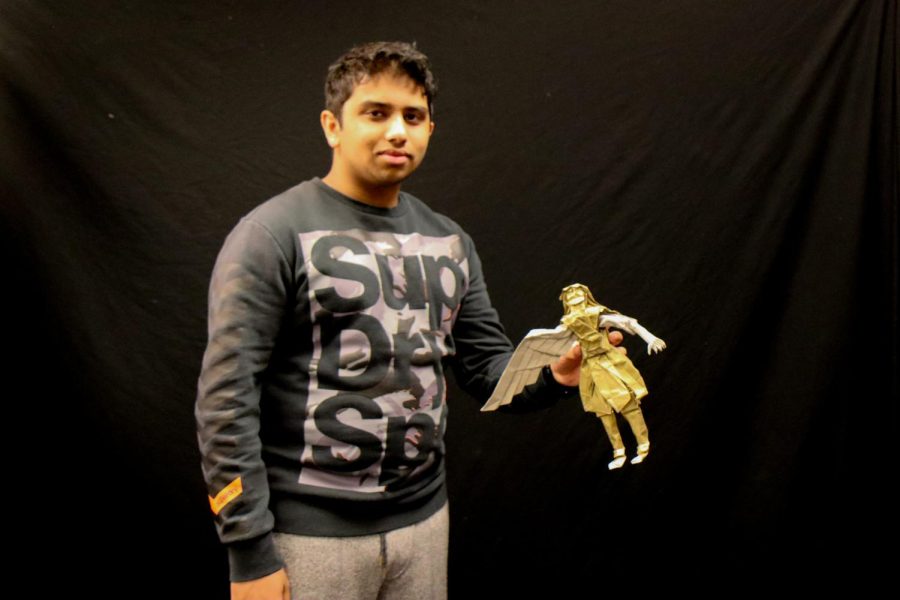Shreyas Malladi unfolds his creativity through origami art
Senior Shreyas Malladi expertly folds inventive and complex origami creations.
March 10, 2023
Surrounded by a stack of paper and intricate designs, senior Shreyas Malladi expertly folds inventive origami creations. Malladi designs his own pieces by hand and through an online software called Pepakura, creating complex figures ranging from humanoids to dragons.
Malladi started his origami journey in his second grade, where his teacher encouraged artistic pursuits in the class. Many students picked up origami, and while it was seen as a pastime to others, the art piqued Malladi’s interest and he continued to flex his skills in the field. He used crease patterns, layouts that show fold lines, to improve his craft-making, before creating his own. He shares some of his models on social media, enters origami competitions and makes gifts for his friends and family. Recently, Malladi created an origami violinist as a gift to his previous employer, who was a violinist at Carnegie Hall.
“The best way I’ve improved is by surrounding myself with an origami community,” Malladi said. “I talk to a lot of other creators online; they’re very open to sharing crease patterns and happy to see someone else make their designs.”
Origami uses a specific type of paper, like tissue-foil or double-tissue, to make models that are light and strong. Malladi started by following folding instructions on YouTube, actively following origami creators such as Jo Nakashima and Tadashi Mori. Often, these instructions included crease patterns that set up different head-to-body ratios. Using this method, Malladi usually creates dragons as it is easier to partition the different parts of these models.
Another technique that Malladi currently uses is crease pattern collapses, specifically box-pleats. These patterns often have no specific order or instructional guides. He starts by creating a grid that acts as a base for the model consisting of lines that increase accordingly with the complexity of the model. He then draws diagonal lines that connect the intersections of the lines, creating a pattern of how and where to fold the paper into a shape. Then, Malladi examines the series of folds to evaluate how the crease pattern collapses and forms a base model. After creating this base, he wet-folds, dousing parts of the model in methylcellulose or water to shape the model. In the final step, he uses wire or glue to highlight the model’s features.
For one exhibition, Malladi created a creature called the “Divine Dragon.” He made this piece based on a simpler crease pattern from an instructional model. His friend, senior Saahil Gupta, 3-D printed a stand for the model to highlight the piece.
“We tend to work alongside each other a lot, as he’ll be working on his origami and I’ll be doing a coding project,” Gupta said. “I’m really grateful for that since it’s more fun to work alongside somebody.”
Malladi makes his own designs with Pepakura, a Japanese software used to simulate the folding of designs to make different bases and creations. He uses angle references and other crease patterns to create models with more complex folding. Some of his favorite pieces include a “Chainsaw Man” figurine and a Japanese Thunder God figurine, which was displayed in a gallery for a few weeks. Malladi usually recreates complex-patterned models that look unique and challenging to build.
“He’s always been talented at origami,” Gupta said. “Origami requires a lot of patience and grit to complete, but now he’s become more accustomed to the work that doing origami has become a natural thing for him.”
Inspired by technical applications of origami in society, such as physicist and origami artist Robert Link, who created a model to fold parts of the James Webb Space Telescope during launch, Malladi hopes to use origami to further his career in mechanical engineering. He wants to create more optimized, folded models of machines for storage and transportation purposes, using origami’s folding techniques. Intertwining origami with engineering has opened pathways between robotics and avionics research, in which Malladi hopes to find more pragmatic engineering solutions to problems left unsolved in the past.
“I’ve always felt a stigma to let go of origami because it seems like more of a hobby, but I’m glad I didn’t let it go,” Malladi said. “It’s a stress reliever, but it’s also helped me with job opportunities and opening up a wide field of careers.”





























































